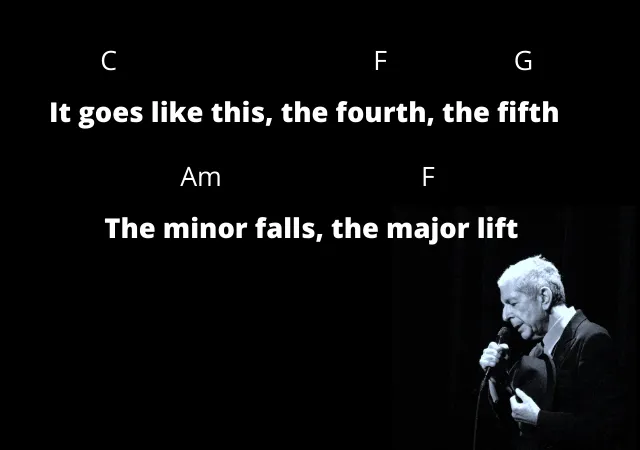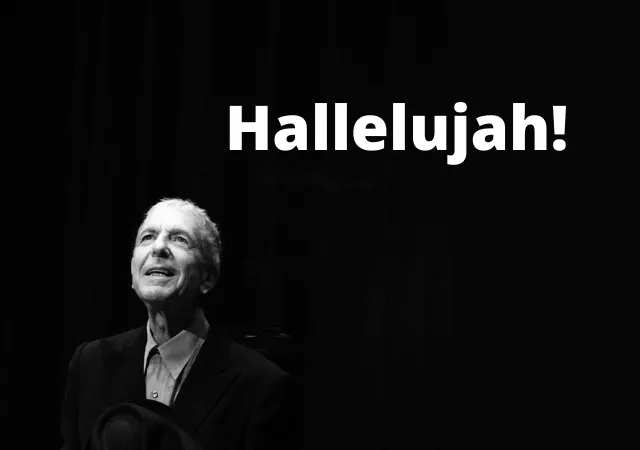
Creo que, al igual que muchos, la primera vez que escuché esta canción fue cuando vi Shrek (una gran película, por cierto) en una versión interpretada por el cantautor galés John Cale. Pero no le había prestado la mayor atención a la letra y lo que realmente se quedó pegado en mi cabeza fue la melodía.
Un tiempo después escuché una versión de Il Divo en español. La verdad me gustó mucho y terminó en convertirse en mi versión favorita.
Sin embargo, en determinado momento quise intentar cantarla y me encontré con la sorpresa de que su autor original es el sr. Leonard Cohen y que su letra en inglés posee un significado lleno de mucho debate hasta estos días.
I think, like many others, I first heard this song when I saw Shrek (a great movie, by the way) in a version performed by Welsh singer-songwriter John Cale. But I hadn't paid the greatest attention to the lyrics and what really stuck in my head was the melody.
Some time later I heard a version of Il Divo in Spanish. I really liked it and it ended up becoming my favorite version.
However, at a certain moment I wanted to try to sing it and I found myself with the surprise that its original author is Mr. Leonard Cohen and that its lyrics in English have a meaning full of much debate until these days.
Lamentablemente el sr. Cohen falleció en el 2016. Pero dejó algunas nociones de lo que esta puede significar en realidad, en lo que a "Hallelujah" se refiere, dijo:
Unfortunately Mr. Cohen passed away in 2016. But he left some notions of what this one might actually mean, as far as "Hallelujah" is concerned, he said:

ES "El mundo está lleno de conflictos y de cosas irreconciliables. Pero hay momentos en los que podemos conciliar y abrazar todo este desastre y eso es lo que quiero decir con "Hallelujah".
La canción explica que existen muchos tipos de Hallelujahs, y tanto los perfectos como los defectuosos tienen el mismo valor. Es el deseo de afirmar mi fe en la vida, no en un sentido religioso sino con entusiasmo, con emoción".
Muchos han considerado que su letra encierra cierto mensaje religioso o sexual. Que presenta en sí misma las contradicciones propias de estos temas, de la naturaleza humana o de la simple ambigüedad con la que afrontamos nuestra realidad.
Ahora, puede que no tenga nada que ver con esto. O tal vez sí. Pero eso es lo genial de la música y de esta canción en particular. La razón por la que puede tener diferente significados para distintas personas, incluyendo a su autor, es por la capacidad de conectar con distintas formas de pensar y sentir. Ya había hablado algo parecido en mi entrada anterior sobre Welcome Home (Sanitarium) de Metallica.
Entonces, ¿Qué es lo que me gusta de esta canción? El uso del figuralismo en el primer verso. Pero...
¿Qué frijoles es el figuralismo?
En palabras sencillas, es un recurso musical existente desde el renacimiento, en el que la música se subordina al texto. Es decir, se desarrollan formas musicales, como melodías o armonías que esten relacionadas con lo que describe el texto.
Por ejemplo, ¿Han escuchado Happy de Pharrell Williams? Hay una parte de la canción en la que el dice My level's too high, y cuando dice esta última palabra realiza una nota alta. Algo como eso.
Many have considered that his lyrics contain a certain religious or sexual message. That it presents in itself the contradictions inherent to these themes, to human nature or to the simple ambiguity with which we face our reality.
Now, maybe it has nothing to do with this. Or maybe it does. But that's what's great about music and this song in particular. The reason it can have different meanings for different people, including its author, is because of its ability to connect with different ways of thinking and feeling. I had already talked something similar in my previous post about Metallica's Welcome Home (Sanitarium).
So, what do I like about this song? The use of word painting in the first verse. But...
What the beans is word painting?
Simply put, it's a musical resource that has been around since the Renaissance, in which the music is subordinated to the text. That is, musical forms are developed, such as melodies or harmonies that are related to what the text describes.
For example, have you heard Happy by Pharrell Williams? There is a part of the song in which he says My level's too high, and when he says this last word he makes a high note. Something like that.
 n't really care for music, do ya It goes like this, the fourth, the fifth The minor fall, the major lif.jpg](https://images.ecency.com/p/2dk2RRM2dZ8gKjXsrozapsD83FxL3Xbyyi5LFttAhrXxr16mCe4arfLHE1ZZDYouMT4fwCKPS4ZpnvRHgQb7bzDShxDsmpUPbyjEK9PTyUv4Z3hKk6DyUDRdMb3s5MLcZm52sSBpfZFNugDiKFpursr7359J1fyx6JYXoiQwXU.png?format=match&mode=fit)
Por ejemplo, este primer verso contiene en sí mismo referencias bíblicas y descriptivas. Por un lado, habla del rey David, quien era capaz de traer paz a Saúl (su predecesor) con su arpa. En esta primera etapa la armonía se mueve entre un modo mayor (feliz, alegre, soleado) y otro menor (triste, nostálgico, nublado). De modo que la música también da cuenta de la ambigüedad que se describirá a lo largo de la canción. También cuando menciona qué acordes "usaba" David, estos corresponden con el sentido de la progresión armónica. Me explico.
En la música, cada tonalidad posee un grupo de acordes que les son naturales y presentan una función específica. En Do Mayor tenemos:
For example, this first verse contains in itself biblical and descriptive references. On the one hand, it speaks of King David, who was able to bring peace to Saul (his predecessor) with his harp. In this first stage the harmony moves between a major mode (happy, joyful, sunny) and a minor mode (sad, nostalgic, cloudy). So the music also accounts for the ambiguity that will be described throughout the song. Also when it mentions which chords David "used", these correspond with the sense of the harmonic progression. Let me explain.
In music, each key has a group of chords that are natural to them and present a specific function. In C major we have:

Junto con la letra, estos acordes cambian de esta manera:
Together with the lyrics, these chords change in this way

Cuando dice fourth (cuarto) hace F (Fa), el cuarto acorde de la escala. Cuando dice fifth (quinto) hace G (Sol), el quinto acorde de la escala. Cuando dice minor fall (el menor cae) hace Am (La menor) y cuando dice major lift (el mayor asciende) hace F (Fa mayor) nuevamente.
When he says fourth he makes F, the fourth chord of the scale. When he says fifth he makes G, the fifth chord of the scale. When it says minor fall it makes Am (A minor) and when it says major lift it makes F (F major) again.
Cuando dice the minor falls, the major lift, podría estar haciendo referencias a justos y pecadores, mientras que unos ascienden otros caen. O tal vez a la dualidad entre el diablo y Jesucristo, el primero cae a los abismos y el segundo sube a los cielos. O cualquier otra cosa por el estilo.
When it says the minor falls, the major lift, it could be referring to the righteous and sinners, while some ascend, others fall. Or perhaps to the duality between the devil and Jesus Christ, the former falls to the abyss and the latter rises to heaven. Or anything else like that.

El uso de figuralismos y de letras profundas llenas de signidicado, junto a un ritmo ternario estilo rock-gospel dotan a esta pieza de una energía muy espiritual y hasta catártica. Y cada vez estoy deseando más el poder cantarla, a lo mejor me animo jaja
The use of word painting and deep lyrics full of meaning, together with a rock-gospel ternary rhythm give this piece a very spiritual and even cathartic energy. And I'm looking forward to sing it more and more, maybe I'll cheer it up lol
¿Qué les parece? Me gustaría saber sus opiniones sobre ella.
Si este post te gustó lo suficiente, me haría muy feliz tu upvote. También pueden seguirme y sugerirme alguna canción de la que quisieran que hablara.
Muchas gracias por leer.
What do you think? I'd love to know your opinions about it.
If you liked this post enough, I would be very happy with your upvote. You can also follow me and suggest any song you would like me to talk about.
Thank you very much for reading.

SOURCES
Wikipedia
Pexel
Pixabay
